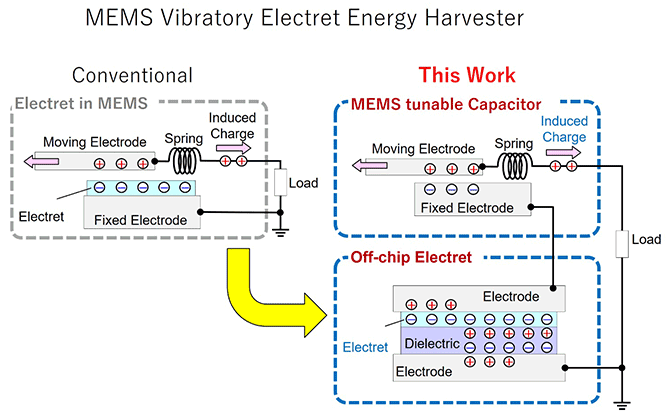Jan 28 2019
At Tokyo Institute of Technology (Tokyo Tech), researchers have created a micro-electromechanical energy harvester that enables much more design flexibility, which is important for upcoming Internet of Things (IoT) applications.
 Conventional Versus Proposed MEMS Energy Harvesters. Unlike conventional electret-based MEMS energy harvesters, which contain the entire system in a single chip, the proposed design methodology involves having the electret and the MEMS tunable capacitor in different chips, loosening up design constraints. (Image credit: Daisuke Yaman)
Conventional Versus Proposed MEMS Energy Harvesters. Unlike conventional electret-based MEMS energy harvesters, which contain the entire system in a single chip, the proposed design methodology involves having the electret and the MEMS tunable capacitor in different chips, loosening up design constraints. (Image credit: Daisuke Yaman)
Today, the incredible miniaturization of electronic devices has become apparently obvious. The application of tiny sensors in future IoT era could aid in developing innovative applications that can only be visualized in science fiction. Conversely, power is still needed to operate microelectronic devices; here, energy-harvesting micro-electromechanical systems (MEMS) can provide a suitable solution allowing these tiny contraptions to work on ambient energy, like that arising from mechanical vibrations.
As shown in the above figure, traditional MEMS energy harvesters utilize an electret, which is the electrical equivalent of a permanent magnet and in which charge is stored permanently. The electret is positioned in a MEMS tunable capacitor, which is integrated with a moving electrode; ambient forces push this electrode, resulting in the movement of charges. Regrettably, this design is rather limited because the development processes for both the MEMS components and the electret need to be compatible. As a result, a research team, which included Assistant Professor Daisuke Yamane from Tokyo Tech, suggested a novel MEMS electret-based energy harvester that contains a pair of individual chips—one containing a dielectric material and an electret to form another capacitor, and the other for the MEMS tunable capacitor.
This allows us to physically separate MEMS structures and electrets for the first time.
Daisuke Yamane, Assistant Professor, Tokyo Institute of Technology
The electret circuit’s capacitance is fixed (Cfix), while that of the MEMS tunable capacitor (CM) changes based on the elongation of the spring (induced by external vibrations). When CM turns out to be higher than Cfix, it results in a movement of charges and causes the tunable capacitor to gain charge. Similarly, higher Cfix causes the charges to move in the reverse direction and allow the capacitor in the electret circuit to gain charge. Such movements of charges indicate electrical power that can be controlled.
The proposed method can be a promising way to enhance the design and fabrication flexibility of both MEMS structures and electrets.
Daisuke Yamane, Assistant Professor, Tokyo Institute of Technology
Flexible designs would not only expand the limitations for engineers but would also speed up the onset of the IoT era so that its benefits can be truly realized.